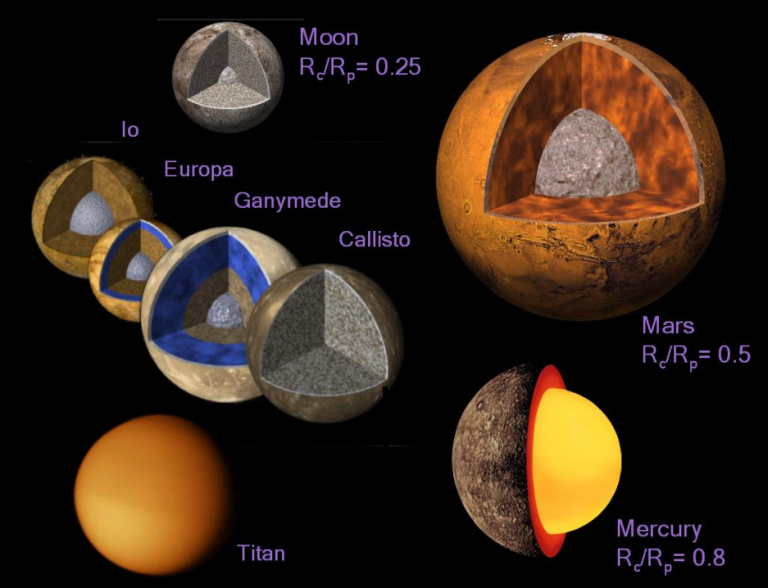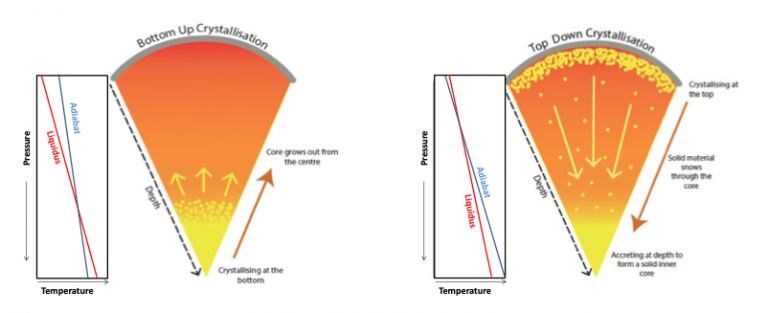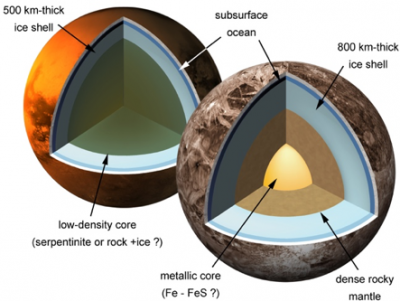Understanding the evolution of the planets and moons presents one of the major challenges in Earth and planetary sciences.
RESEARCH THEME CONTACT:
LIDUNKA VOCADLO
Space missions have revealed that our solar system displays a rich variety of bodies, each with a complex and diverse evolutionary history. To understand planetary evolution, it is essential to construct geophysical models of planetary interiors, the outputs of which can be tested against data from spacecraft and ground-based observations. If these models are to be reliable, the physical properties of the constituent materials must be accurately known in the pressure and temperature range of relevance. At present, this is often not the case for the conditions expected in the metallic cores of the small terrestrial planets (and Ganymede) and the mantles of the icy moons. In the last 20 years there has been a revolution in experimental and computational methods capable of determining the phase equilibria, equations of state, equilibrium properties (density, heat capacity, elasticity, thermal expansivity) and transport properties (electrical and thermal conductivity, viscosity) of iron and its alloys at the pressures and temperatures relevant to the interiors of the Moon, Mercury, Mars and Ganymede. Similarly, in the case of planetary ices, recent developments in computer simulation, X-ray and neutron diffraction are now enabling us to determine key properties of the constituent ‘planetary ices’ under the necessary conditions. However, many of these advances are still to be applied to the relevant planetary materials in the correct pressure and temperature range. Consequently, previous dynamical and thermal evolution models have made simplifying assumptions about equilibrium and transport properties; these simplifications have the potential to dramatically alter the outcome of models of the thermal and dynamical evolution of these bodies.

The door is now wide open for combining observations, experiments and computer simulations with dynamical modelling to tackle some of the fundamental problems concerning the interiors of the planets and moons of our solar system. This theme aims to address major unresolved problems such as:
- What is the regime driving core growth in Mercury? In contrast to the Earth, does Mercury's core crystallise from the 'top-down' instead of 'bottom-up'? Could 'iron snow' explain the observed weak magnetic field of Mercury?

Image: Two possible mechanisms for core crystallisation
Why doesn't Venus have a magnetic field? Being much hotter than the Earth, it is likely that Venus has a metallic liquid outer core, but is unlikely to be convecting. Is there no inner core to drive convection? Or is the core in a steady hot state, i.e., no cooling? Or is a reversal currently occurring (magnetic steady-state)?
What is the state of Mars' core? Although Mars does not have a magnetic field, significant magnetisation of the crustal rocks suggest that a dynamo existed in the past and has since ceased operation. Was this due to the cooling and solidification of the convecting liquid or perhaps some other process involving a change in the dominant heat transfer mechanism?
How have the icy bodies of the outer solar system evolved? The icy bodies of the outer solar system differ widely in internal structure and surface morphology, their current state reflecting the heat generation and transport in their interiors. From the smallest to the largest of these bodies, there is evidence for liquid water beneath an outer shell of ice. As well as being of interest in the search for extra-terrestrial life, subsurface oceans play a pivotal role in thermal evolution; they allow efficient convective heat transport, concentrate tidal dissipation in the overlying crust, release latent heat as they cool and crystallise, and provide liquids that can be intruded into the crust and extruded onto the surface. Interpreting the surface morphologies of icy bodies and understanding their thermal evolution requires accurate geophysical models, for which the properties of their constituent materials must be known. Also crucial is an observational link between materials in the laboratory and those seen in situ; this requires measurement, calculation and analysis of vibrational spectra for comparison with data from orbiters or flybys of distant icy worlds. In-situ exploration of the solar system’s icy bodies has transformed our knowledge of these objects, revealing dynamic worlds with diverse geological histories. For example, Jupiter’s moon Callisto seems scarcely to have differentiated and to have experienced little endogenic activity, whereas Ganymede (see figure) is differentiated, with a probable liquid iron core generating an intrinsic magnetic field, and a surface mouldedby a billion years of extensional activity and cryovolcanic flooding. Saturn’s moon Titan (see figure) has a low-density core, consisting of either a rock-ice mixture or hydrous silicates (there is no Fe inner core, and no magnetic field), and yet it has outgassed to create a dense atmosphere. In all three cases, there is evidence for global oceans under 10s to 100s of km of ice.

Image: Titan (left) and Ganymede (right) have similar radii and bulk densities, but different interiors and evolutionary histories.
Underpinning the planetary interiors theme is the established Crystallography and Mineral Physics Group (CMP) within UCL Earth Sciences. We have infrastructural equipment support including X-ray diffractometers, IR and Raman spectrometers, large-volume presses, uniaxial and triaxial creep rigs. In addition to this, we collaborate with colleagues working at international facilities, such as ISIS (for neutron scattering) and the ESRF (for X-ray studies). Computer calculations are supported by the Mineral Physics computer consortium which gains regular access to national supercomputing facilities. The combination of theoretical and experimental techniques, combined with dynamical modelling and, of course, observations allow us to interrogate the interiors of planets and moons to better understand their origin and evolution.
 Close
Close

